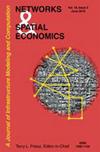俄罗斯地区生育率和女性失业率
IF 1.5
3区 工程技术
Q3 OPERATIONS RESEARCH & MANAGEMENT SCIENCE
引用次数: 1
摘要
本文使用2000-2021年俄罗斯联邦82个地区的面板数据,研究了生育率的经济和人口决定因素。采用面板协整技术,考察总生育率与这些因素之间是否存在长期均衡关系。研究表明,生育率的增长主要是由于结婚率、老年人口负担、女性工资、国内劳动力迁移和女性失业率的增长,而生育率的下降则与女性经济活动和城市化有关。2000-2011年,兴奋剂的联合作用优于抑制剂的联合作用,TFR呈增长趋势。2011-2021年,女性经济活动和城市化的负面影响增加,总生育率开始下降。格兰杰因果关系检验表明,女性成对失业、经济活动和城市化导致生育能力,但不是亦然,而因果关系是双向的在其他情况下。这些结果支持一些理论预测和经验证据,并与其他一些相矛盾本文章由计算机程序翻译,如有差异,请以英文原文为准。
Fertility and Female Unemployment in Russian Regions
This paper examines economic and demographic determinants of fertility, using panel data for 82 regions of the Russian Federation for 2000–2021. Panel co-integration technique is used to find out whether there exists a long-term equilibrium relationship between total fertility rate (TFR) and these determinants. We show that the growth of TFR is due largely to the growth of nuptiality rate, old age demographic burden, female wages, domestic labor migration and female unemployment rate, while the decline is associated with female economic activity and urbanization. In 2000–2011 the combined effect of stimulants prevailed over the combined effect of inhibitors, and TFR tended to grow. In 2011–2021 the negative impact of female economic activity and urbanization increased, and TFR began to decline. Pairwise Granger causality test shows that female unemployment, economic activity and urbanization cause fertility, but not vice versa, while causation is bidirectional in other cases. These results support some theoretical predictions and empirical evidence and contradict some others
求助全文
通过发布文献求助,成功后即可免费获取论文全文。
去求助
来源期刊

Networks & Spatial Economics
社会科学-运筹学与管理科学
CiteScore
4.00
自引率
4.20%
发文量
26
审稿时长
>12 weeks
期刊介绍:
Networks and Spatial Economics (NETS) is devoted to the mathematical and numerical study of economic activities facilitated by human infrastructure, broadly defined to include technologies pertinent to information, telecommunications, the Internet, transportation, energy storage and transmission, and water resources. Because the spatial organization of infrastructure most generally takes the form of networks, the journal encourages submissions that employ a network perspective. However, non-network continuum models are also recognized as an important tradition that has provided great insight into spatial economic phenomena; consequently, the journal welcomes with equal enthusiasm submissions based on continuum models.
The journal welcomes the full spectrum of high quality work in networks and spatial economics including theoretical studies, case studies and algorithmic investigations, as well as manuscripts that combine these aspects. Although not devoted exclusively to theoretical studies, the journal is "theory-friendly". That is, well thought out theoretical analyses of important network and spatial economic problems will be considered without bias even if they do not include case studies or numerical examples.
 求助内容:
求助内容: 应助结果提醒方式:
应助结果提醒方式:


